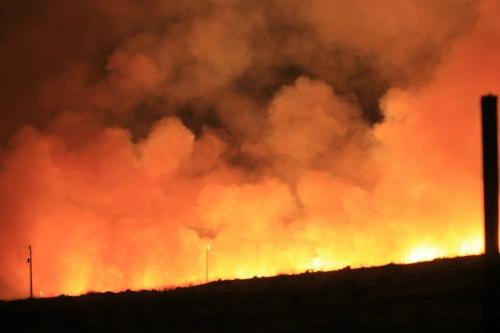Guidelines for Horses Exposed to Wildfire Smoke

Fires throughout California and the western United States in recent years have exposed humans and horses to unhealthy air containing wildfire smoke and particulates. These particulates can build up in the respiratory system, causing a number of health problems for both species.
UC Davis equine specialists have offered these suggestions to serve as a general guide on the effects of horses breathing air laden with particulates.
What Is In Smoke?
Smoke is composed of carbon dioxide, carbon monoxide, particulate matter, soot, hydrocarbons and other organic substances, including nitrogen oxides and trace minerals. Different types of wood, vegetation, plastics, house materials, and other combustibles produce different compounds when burned, which affect the composition of the smoke.
Particulate matter is the major pollutant of concern in wildfire smoke. Particulate is a general term used for a mixture of solid particles and liquid droplets found in the air. Particulates from smoke tend to be very small at less than one micron in diameter, which allows them to reach the deepest airways within the lung.
How Smoke Affects Horses
The effects of smoke on horses are similar to the effects on humans and can include irritation of the eyes and respiratory tract, aggravation of conditions like heaves (recurrent airway obstruction), and reduced lung function. High concentrations of particulates can cause persistent cough, increased nasal discharge, wheezing, and difficulty breathing. Particulates can also alter the immune system and reduce the ability of the lungs to remove foreign materials, such as pollen and bacteria, to which horses are normally exposed.
Assessing and Treating Smoke Inhalation in Horses
Horses exposed to fire smoke can suffer respiratory injury of varying degrees, ranging from mild irritation to severe smoke inhalation-induced airway or lung damage. Knowing what is normal can help you determine whether your horse may need veterinary attention.
Have your horse(s) examined by a veterinarian if any of the following are noted:
- Respiratory rate is consistently greater than 30 breaths/minute at rest.
- Nostrils have obvious flaring.
- There is obvious increased effort of breathing when watching the horse’s abdomen and rib cage.
- There is repetitive or deep coughing, or abnormal nasal discharge.
Protecting Horses from Air Pollution

There is currently no available scientific data specifically regarding the impacts of various air quality index (AQI) levels on equine respiratory health. The American Lung Association provides guidelines and color-coding for AQI ranges, with green being the lowest (0-50) and maroon (301-500) the highest. These guidelines have generally been extrapolated for horses as well. The United States Equestrian Federation (USEF) recommends that event organizers consider cancelling or suspending competitions if the AQI reaches 151 or above. Work with your veterinarian to determine the best plans for your individual horses, particularly if there is a history of respiratory issues such as heaves, asthma, or allergies.
Additionally, consider the following actions:
- Limit activities that increase airflow in and out of the lungs (i.e. exercise), which can trigger narrowing of the small airways in the lungs, when smoke is visible.
- Provide plenty of fresh water close to where your horse eats. Horses drink most of their water within two hours of eating hay, so having water close to the feeder increases water consumption. Water keeps the airways moist and facilitates clearance of inhaled particulate matter. This means the windpipe (trachea), large airways (bronchi), and small airways (bronchioles) can move the particulate material breathed in with the smoke. Dry airways cause particulate matter to stay in the lung and air passages.
- Limit dust exposure by feeding dust-free hay or soak hay before feeding. This reduces the particles in the dust such as mold, fungi, pollens and bacteria that may be difficult to clear from the lungs.
- Contact your veterinarian if your horse is coughing or having difficulty breathing. A veterinarian can help determine the difference between a reactive airway from smoke and dust versus a bacterial infection and bronchitis or pneumonia. If your horse has a history of heaves or recurrent airway problems, there is a greater risk of secondary problems such as bacterial pneumonia.
- If your horse has primary or secondary problems with smoke-induced respiratory injury, contact your veterinarian who can prescribe specific treatments such as intravenous fluids, bronchodilator drugs, nebulization, or other measures to facilitate hydration of the airway passages. Your veterinarian may also recommend tests to determine whether a secondary bacterial infection has arisen and is contributing to the current respiratory problem.
- Give your horse ample time to recover from smoke-induced airway insult. Airway damage resulting from wildfire smoke takes four to six weeks to heal. Ideally, give your horse that amount of time off from the time when the air quality returns to normal. Attempting exercise may aggravate the condition, delay the healing process, and compromise your horse’s performance for many weeks or months. Horses should return to exercise no sooner than two weeks post smoke-inhalation, following the clearance of the atmosphere of all smoke.
Read the full article at: https://www. vetmed.ucdavis.edu/news/guidelines-horses-exposed-wildfire-smoke.
